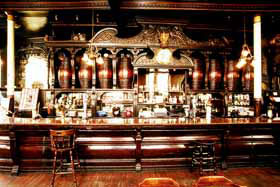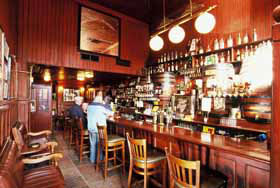
Once upon a time most country pubs were very simple affairs, often little more than a room in someone’s house where beer (or cider in some regions) was sold. There are still a handful left but, sadly, they have been going rapidly over the past few decades. You can experience them at the Sun, Leintwardine, Herefordshire; the Luppitt Inn, Devon; the Red Lion, Ampney St Peter, Gloucestershire; and the Fiddichside Inn, Craigellachie, Moray, for example.

Red Lion, Ampney St Peters - Picture: Michael Slaughter
Elsewhere you can also find traces of such basic country pubs in premises that have expanded to create viable businesses. The old, small historic core has been carefully preserved at, for instance, the Drewe Arms, Drewsteignton, Devon; the Cross Keys, Selattyn, Shropshire; the Five Mile House, Duntisbourne Abbots, Gloucestershire; the Fox, Ysceifiog, Flintshire; and the Barley Mow, Kirk Ireton, Derbyshire.

Tuckers Grave, Faukland - Picture: Michael Slaughter
Just as country pubs were a focus of rural life, so basic back-street locals often formed the heart of working class urban communities. Typically they have a public bar (where the counter is found) and one or more ‘better’ rooms where the drink used to cost a little more. Few remain much as they did a century ago but you can still enjoy the original character of such pubs at the Turf Tavern, Bloxwich, West Midlands; the Vine, Tunstall, Staffordshire; the Oxford Bar, Edinburgh; the Railway, West Calder, West Lothian; and the Railway, Altrincham, Greater Manchester.

Oxford Bar, Edinburgh - Picture: Michael Slaughter

Vine, Tunstall - Picture: Michael Slaughter
The ‘golden age’ of pub building in the UK was around 1900. Pubs were then having to compete as never before for people’s disposable cash against attractions like organised sports, varied theatrical entertainments (and soon the cinema), excursions, and – quite new for the working classes – holidays by the sea. The temperance movement had been active since the early Victorian period campaigning against the evils of drink and the places where it was consumed: if pubs couldn’t all be closed, they ought to be reduced in number and improved. And the brewers were the people to do it! They were busy buying up pubs to tie up the supply and spent huge amounts in making them more attractive places to drink.
The most magnificent pubs from the late Victorian and early Edwardian pub-building boom are the Philharmonic and also Vines in Liverpool, and the Crown Bar, Belfast. Superb examples can be found in central London at the Princess Louise Holborn, and the Argyll Arms right by Oxford Circus tube station. Leeds has the Garden Gate; Birmingham the Bartons Arms; Edinburgh the Café Royal and Bennet’s Bar; Glasgow the Horseshoe Bar and Old Toll Bar.

Philharmonic, Liverpool - Picture: Michael Slaughter

Barton Arms, Birmingham - Picture: Michael Slaughter

Crown, Belfast - Picture: Michael Slaughter
The campaign to improve pubs that started under the Victorians continued after the First World War. The idea was ‘fewer and better’ – hence massive pubs in the suburbs which served a wide area and offered a range of facilities in addition to drink. There were sports facilities, meeting rooms, even gardens for the kids to play in. Women were welcomed. Good examples are the Margaret Catchpole, Ipswich; the Black Horse, Northfield, Birmingham; the Doctor Johnson, Barkingside, London; and the Test Match Hotel, West Bridgford, Nottinghamshire.

Margaret Catchpole, Ipswich - Picture: Michael Slaughter
Of course, not all pubs went up on such a scale and places where you will find more modest, unspoilt establishments are the Vine, Wednesfield, West Midlands; the Clep, Dundee; and Hope & Anchor, Hammersmith, London.
But there was also a nostalgic streak behind all this and ‘Brewers’ Tudor’ – a romantic evocation of the past was popular: grandiose examples can be visited at the Cittie of York, Holborn, London; the Black Horse, Northfield, Birmingham (again); and the Cumberland Inn, Carlisle.
By way of contrast, a particular pleasure of inter-war pubs is the occasional appearance of the sleek lines of Art Deco architecture and fittings. Fine examples can be found at the Steps Bar, Glasgow; Portland Arms, Shettleston, also Glasgow; and the Test Match Hotel, West Bridgford (again).

Portland Arms, Glasgow - Picture: Michael Slaughter
After the devastating economic effects of World War Two, pub-building did not get going again until the mid-1950s. Planning remained traditional in the sense that plans involved multiple rooms but materials were, necessarily, cheap and undistinguished while designs featured sharp, angular shapes. Most early post-war pubs have been considerably altered in recent decades but the National Inventory of Historic Pub Interiors features four which are still intact and give you a flavour of what was being provided for pub-goers around 1960: Lauriestoun Bar, Glasgow: March Hare, Ashton-under-Lyne, Greater Manchester: Longacre Tavern, Bath; and Rutherfords, Edinburgh.

Laurieston Bar, Glasgow - Picture: Michael Slaughter

Longacre Tavern, Bath - Picture: Michael Slaughter
As with most building types, you can find differences in pub styles from region to region. But the most conspicuous differences lie between England and Wales on one hand and Scotland and Northern Ireland on the other. As a broad generalisation pubs in the former tend to be more conspicuous visually and were multi-roomed, whereas in the latter they are often almost indistinguishable from ordinary shops and a single bar was quite common (but sometimes with small sitting rooms or booths leading off). The long spirit-drinking tradition in Scotland and Northern Ireland has ensured the survival of numerous spirit casks in gantries (back-fittings) at the back of many a servery, such as at the Old Toll Bar, Glasgow; Bennet's Bar, Edinburgh in Scotland and Blake's Bar, Enniskillen and Central Bar, Irvinestown in Northern Ireland.

Toll Bar, Glasgow - Picture: Michael Slaughter

Central, Irvinestown - Picture: Michael Slaughter